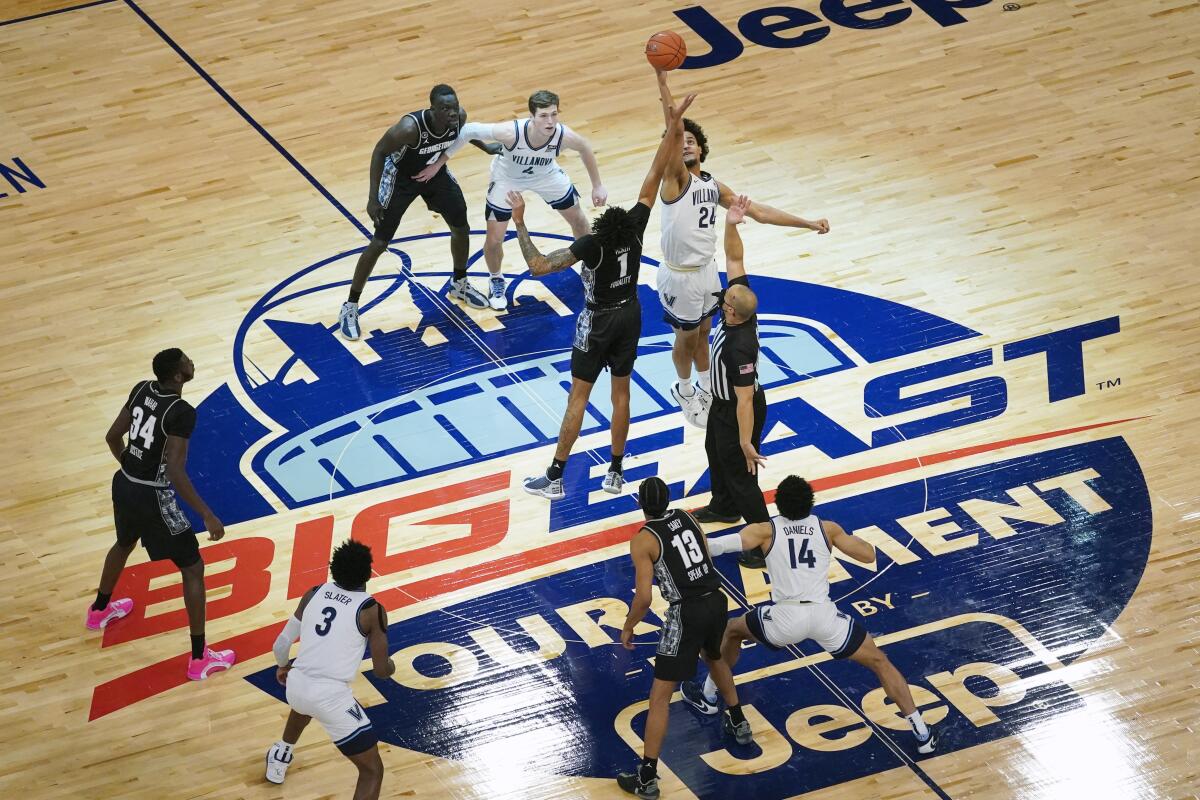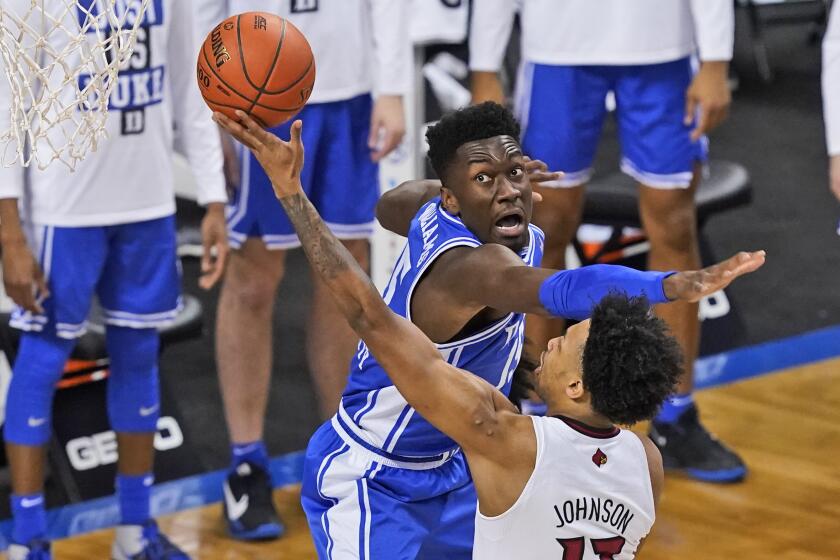NCAA tournament betting guide: 10 tips on how to win March Madness

- Share via
It’s been two long years since sports bettors have had the privilege of getting down on March Madness. The pandemic robbed us of last year’s NCAA tournament, but luckily the most exciting betting event of the year is back. Wagering on the “Big Dance” is different from wagering on a regular-season matchup. The stakes are higher, the lines are sharper and the betting handles are higher. Without further ado, here are a few tips to keep in mind as you wager on the madness.
1. Go contrarian
The premise of contrarian betting is pretty simple. More often than not, the public loses. As a result, you want to be against the crowd and with the house. The public bets based on gut instinct and bias, which is a recipe for disaster long term. If you walk into a bar and everyone is betting on Team A, you probably want to be holding a ticket on Team B. March Madness is the best time of year to go contrarian. The buzz and excitement of the NCAA tournament draws an influx of casual bettors. They might not have bet all season but they want to get in on the fun. With public betting flooding the market, the ticket counts skyrocket. This means the market is saturated with public bias, providing more value than ever to go against the grain. This NCAA tournament could provide even more contrarian value than usual due to pent-up demand after a year off. Also, more states have legalized betting, leading to more public bettors getting down on these games, many for the first time this year.
What does this all mean in practical terms? Well, the public will almost certainly gravitate toward favorites, higher ranked teams, big name schools and teams with star players and better records. As a result, contrarian bettors should focus on underdogs. There is also an element of “madness” at play, which makes underdogs more valuable because upsets are more prevalent than in regular-season play.
Duke’s elimination from the ACC tournament because of a positive coronavirus test serves as a warning of the fragility for the NCAA tournament field.
2. Look for inflated lines
When betting on dogs, focus on the most unpopular dogs each day. These often provide the most value. Also, look for inflated lines. This means the public is so heavy on one side that the line moves and you can buy low on a dog getting “free points.” For example, let’s say a favorite opens -2.5 and lopsided action moves the line to -4.5. There isn’t much value to laying the points at -4.5 since you are late to the party and getting the worst of the number. Instead, look to buy low on the dog at +4.5. You are getting two points of inflated line value off the opener.
3. Reverse Line Movement
Going contrarian is a good foundational pillar but it only gets you halfway. The other important ingredient is being with the smart money. This means being on the same side as the sharps who bet professionally and have the respect of the books. One of the easiest ways to locate sharp action is through reverse-line movement. This is when the betting line moves away from the popular side and toward the unpopular side. For example, let’s say 75% of bets are on Texas. Yet you see the Longhorns fall from -7 to -6.5 or -6. This would signal pro money grabbing the points with the dog. Another move to look out for is a “dog to favorite” flip. If a team opened at +1.5 but moves to -1.5 that is significant. I like to moneyline these teams that “hop the fence.”
4. Embrace fishy lines
If it looks too good to be true, it almost always is. That statement will take you a long way in sports betting. Look for lines that don’t make sense and lean on them. For example, maybe you see a 9-seed favored over an 8-seed. Or a team with a worse won-loss record favored over a team with a better won-loss record. In both instances, the public will rush to back the 8-seed or the team with the better record. But oftentimes going the other way and backing the team that “doesn’t make sense” can be the smarter move. If something stinks, there’s a reason behind it.
5. Lean on Ken Pomeroy
Sharp college hoops bettors have been leaning on Ken Pomeroy projections for years. His advanced analytics are the best in the game and incredibly accurate. If a dog is getting 5 points but Pomeroy has them losing by 3 points, that’s value worth backing. Or maybe a favorite is -2 but Pomeroy has them winning by four. These are the spots to take advantage of. The ultimate situation is when Pomeroy has a team winning the game but they are getting points as a dog. Look for the biggest discrepancies and lean on them.
6. Moneyline short favorites

If you like a short favorite (anything -3 or less), think about backing them on the moneyline instead of laying the points. Why? Because these games can be incredibly tight and competitive. Upsets are prevalent and so are back door covers. You have to pay a little higher juice, but it will provide you security and peace of mind knowing that you just need to win the game. You would hate to bet a team at -1.5 or -2 and then they win by one point. In this instance, you lose your bet when you would have won if you took the moneyline. Maybe you lay a -1 and the team wins by one and you push. Maybe your team is down by one point and hits a buzzer beater to win by one. Or maybe your team is up 5 and the opponent hits a worthless three at the end to make it a 2-point win. You laid -2.5 instead of going moneyline, so you lose. In all of these crazy situations, moneylining would provide a win when laying the points would be a loss.
7. Buy low and sell high on big total moves
If you like betting totals, look out for huge fluctuations where you can take advantage of an inflated or deflated number. For example, maybe a total opens 130 and gets bet down to 126. Yes, the under likely took in some respected money. But if you take under 126 you are getting the worst of the number after the value is all gone. Instead look to buy low and go over, especially if Pomeroy has the total at maybe 129 or 130. You can do the same thing with unders. Maybe the Gonzaga total rises from 150 to 155. Buying low on the under 155 (especially if Pomeroy has a 152) might be a smart move as you are getting the “high water mark.” Also, lean on pace stats. If you’re betting an under, you want slow, deliberate teams who chew up the clock. If you’re betting an over, look for quick, fast-paced teams that have a lot of possessions and, therefore, have more opportunities to put up points.
8. Track late moves
Tracking line movement is key when it comes to understanding where the money is flowing. Late moves are oftentimes the most meaningful because they take place when sportsbooks’ limits are the highest and the biggest wagers from sharps come in. Look for line movement in the last half hour or final minutes before a game tips off. For example, maybe a line is at 7 all day, but in the last few minutes before tip you see it fall to 6.5. That would signal some respected money grabbing the points with the dog. Also, read juice prices to anticipate the next move. Maybe you like a dog at +6.5 and you see the juice move from -110 to -115. This signals a possible dip to 6, which means you should grab the hook quickly before it falls.
USC will play the Wichita State vs. Drake winner on Saturday at 1:30 p.m. UCLA will face Michigan State in a First Four game on Thursday at 6:57 p.m.
9. Pick the champion in your bracket first
March Madness isn’t just about betting the individual games. We all love filling out brackets, too. In order to win your bracket, you need to stand out from the pack. If you go chalk like everyone else, you won’t differentiate yourself from the crowd. Most people fill out their brackets from the outside, starting with the Round of 64. Instead, start from the inside and work your way out. Why? Because scoring formats give more points the further each team advances. A win in the first round might only be one or two points. But a win in the Elite 8, Final Four and championship might be 8, 10 or 12 points. This means your most important pick is the one you have winning the tournament. First, pick a champion. Look at futures odds from the sportsbooks. Then look at the bracket percentages on big sites like ESPN, Yahoo and CBS. Maybe the sportsbooks have Gonzaga, Baylor and Michigan at roughly the same odds to win the tournament. However, Gonzaga is the champion in 75% of brackets. As a result, picking Baylor or Michigan as your champion would be a smart contrarian bet and set you apart from the pack.
10. Shop for the best line
No matter who you bet on during March Madness, make sure you have access to multiple sportsbooks so you can shop for the best line. If you just bet through one book, you are at the mercy of whatever number they are offering. Instead, have multiple outs and place your bet at the book that gives you the best number. Maybe you like Ohio State as a favorite. Your book has them at -7 but another book has -6.5. If they win by seven, you push. But if you shopped around and got -6.5 you would have won. You can also look for lower juice and extra half points on totals. It can be the difference between a win, a loss and push.
Josh Applebaum writes for VSiN, the sports betting network.
Get our high school sports newsletter
Prep Rally is devoted to the SoCal high school sports experience, bringing you scores, stories and a behind-the-scenes look at what makes prep sports so popular.
You may occasionally receive promotional content from the Los Angeles Times.
More to Read
Go beyond the scoreboard
Get the latest on L.A.'s teams in the daily Sports Report newsletter.
You may occasionally receive promotional content from the Los Angeles Times.












